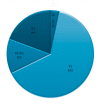Pulsed radiofrequency treatment for trigeminal neuralgia
- PMID: 24904811
- PMCID: PMC4018717
- DOI: 10.5812/aapm.3493
Pulsed radiofrequency treatment for trigeminal neuralgia
Abstract
Background: Pulsed radiofrequency (PRF) treatment is defined as the delivery of short pulses of radiofrequency via a needle tip, which does not result in an actual thermal lesions. There are mixed views regarding the use of PRF for trigeminal neuralgia (TN). In our opinion, one of the main reasons for the contrasting views is the insufficient PRF dose employed in previous studies. In a recent study on the effects of PRF on resiniferatoxin-induced neuropathic pain in an animal model, the anti-allodynic effects of PRF were significantly greater when the PRF exposure duration was increased from 2 to 6 minutes.
Objectives: The primary objective of this retrospective study is to report the results for 36 consecutive patients who underwent PRF treatment for TN, for 6 minutes at 45 V at a pulsed frequency of 4 Hz and a pulse width of 10 ms.
Patients and methods: For the study, we obtained procedural records of 36 consecutive patients. Their current state of pain was evaluated over a telephonic survey and the post-procedural data at 2, 6, and 12 months were retrieved thereafter from the patient records. The main outcome measure was excellent pain relief (more than 80%), which was assessed at 2, 6, and 12 months.
Results: The percentages of patients who showed excellent pain relief (> 80% pain relief) at 2, 6, and 12 months were 73.5% (25/34), 61.8% (21/34), and 55.9% (19/34), respectively. The percentages of patients showing satisfactory pain relief (50-80% pain relief) at 2, 6, and 12 months were 14.7% (5/34), 17.6% (6/34), and 17.6% (6/34), respectively, and those of patients showing less than satisfactory pain relief (< 50% pain relief) at 2, 6, and 12 months were 11.8% (4/34), 20.6% (7/34), and 23.5% (8/34), respectively. No complications were reported, and none of the patients required hospitalization.
Conclusions: PRF of the trigeminal ganglion should be further evaluated as an alternative treatment method for TN.
Keywords: Minimally Invasive; Pain; Pulsed Radiofrequency Treatment; Trigeminal Ganglion; Trigeminal Nerve; Trigeminal Neuralgia.
Figures
References
-
- The International Classification of Headache Disorders: 2nd edition. Cephalalgia. 2004;24(Suppl 1):9–160. - PubMed
-
- Lopez BC, Hamlyn PJ, Zakrzewska JM. Systematic review of ablative neurosurgical techniques for the treatment of trigeminal neuralgia. Neurosurgery. 2004;54(4):973–82. discussion 82-3. - PubMed
-
- van Kleef M, van Genderen WE, Narouze S, Nurmikko TJ, van Zundert J, Geurts JW, et al. 1. Trigeminal neuralgia. Pain Pract. 2009;9(4):252–9. - PubMed
-
- Burchiel KJ. A new classification for facial pain. Neurosurgery. 2003;53(5):1164–6. discussion 6-7. - PubMed
LinkOut - more resources
Full Text Sources
Medical


